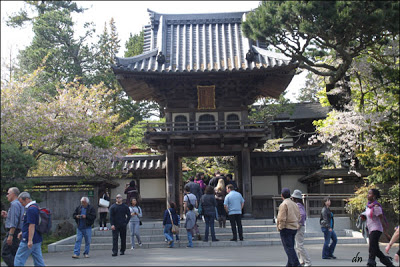
If you have ever been to a Japanese Garden, chances are that you will recognise one the next time you see one, just about anywhere. With their signature bridges, lanterns and Koi ponds, these gardens have ‘Japanese’ written all over them.
The Japanese Tea Garden in San Francisco also showcases Japanese landscape and all the design elements that lend it its ‘Japaneseness’. A booklet I purchased from the souvenir shop says:
In Japanese culture the garden is considered one of the highest art forms. The garden expresses in a limited space, the essence of nature by the use of specially selected plants and stones arranged in harmony with the landscape. Often plants and stones are placed to express a traditional symbolic meaning, or to display the beautiful seasonal colours of trees and shrubs.
Now let me take you around San Francisco’s Japanese Tea Garden and show you all that I saw, and share all that I learnt here.
The main gate

This is the present main gate, which was reconstructed in the April of 1985. The original one (of 1894) had to be removed because it had begun decaying. This ornamental wooden gate owes its creation to Kensute Kawata, a temple builder who designed it and supervised its construction.
NOTE: A Japanese Garden is almost always fenced. The idea is to create an enclosure that serves as an oasis of peace and natural beauty. As such, the ‘gates’ play a major role and act as the exit from the outside world and entry into the green paradise.
The Hagiwara Gate and Sunken Garden

The Hagiwara gate leads to what is now a Sunken Garden, which lies in the site of the the former home of the Hagiwaras (read about them here). This part of the Tea Garden that is set on a lower level is now home to some miniature trees and a clear pond with fish in it.
Tea House and the ni-kai-yashiki (two-storey house)
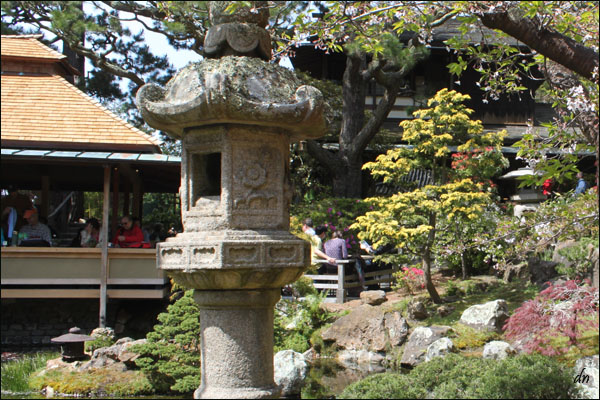
All though they have undergone some restoration, the Tea House Pavilion and the two-storey house are original structures from the Japanese Village that was built for the California Midwinter International Exposition of 1894. The Tea House continues to serve traditional Japanese Tea and Japanese snacks while the two-storey house has been converted into a souvenir shop.
Long Bridge and Stepping Stone

Bridges and Stepping stones (as seen in the picture above) are other inevitable features of a Japanese Garden. Bridges denote the path to immortality and the Stepping Stones symbolise the journey of life.
Zen Garden and Dry (sandy) Ocean
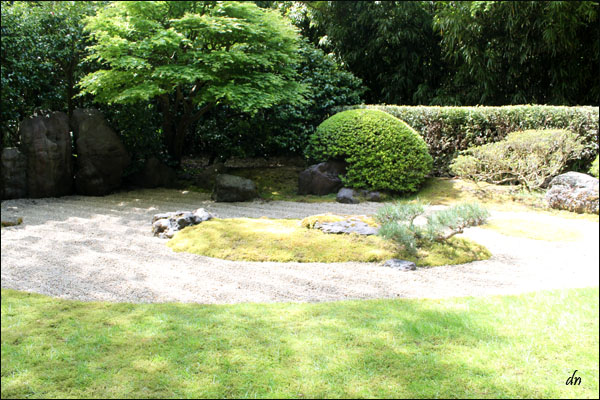
Almost always these gardens have a Zen Garden to facilitate meditation and contemplation. The Zen Garden here in the Japanese Tea Garden, has a miniature mountain with a waterfall and a dry ocean. If you are wondering what a dry ocean is, here is the explanation: since Japan is surrounded by sea waters all around it, the Japanese are said to have an affinity to water. The sand pool, which is raked to create a ripple effect symbolises the ocean and the grassy patch in the middle, an island.
Temple Gate and Pagoda
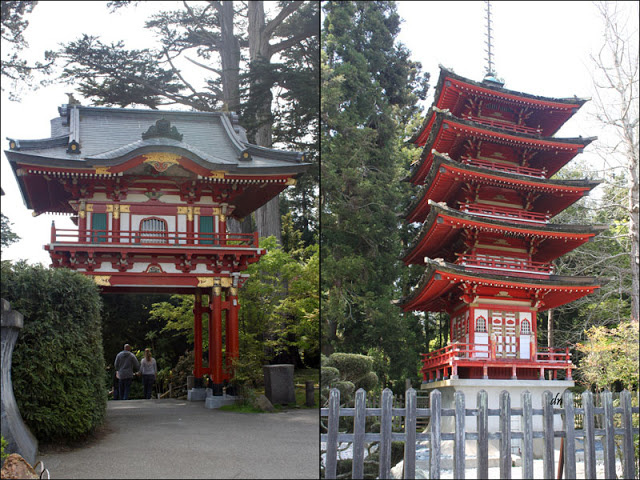
The Pagoda in San Francisco’s Japanese Tea Garden is a tall structure you just cannot miss. Having come up to it from behind, I was hoping that I would be able to get some full-length pictures of the Pagoda. When I got close to it, I couldn’t stop photographing it. I’m sure I’ve got pictures from all angles and close ups of some of the architectural features of this brightly coloured traditional building. A plaque beside it said:
PAGODAS ARE BUDDHIST SHRINES USUALLY MADE OF STONE, BRICK OR WOOD. THEY ARE DERIVED FROM THE STUPA OF ANCIENT INDIA, A FUNERAL MOUND ERECTED OVER THE REMAINS OF A HOLY MAN OR KING. JAPANESE PAGODAS WERE BASED ON CHINESE PROTOTYPES INTRODUCED INTO JAPAN IN THE 6TH CENTURY. THE FIRST STOREY IN LARGER PAGODAS WAS GENERALLY FURNISHED AND CONTAINED AN ALTAR. THE UPPER STOREYS WERE PLAIN AND UNFURNISHED.
It went on to say that this particular pagoda is a Japanese exhibit from the Panama- Pacific International Exposition of 1915.
The stucture beside the Pagoda is the Temple gate. This temple gate was also a reconstruction by Kensuke Kawata in the mid 1980s.
Bronze Lantern and Peace lantern
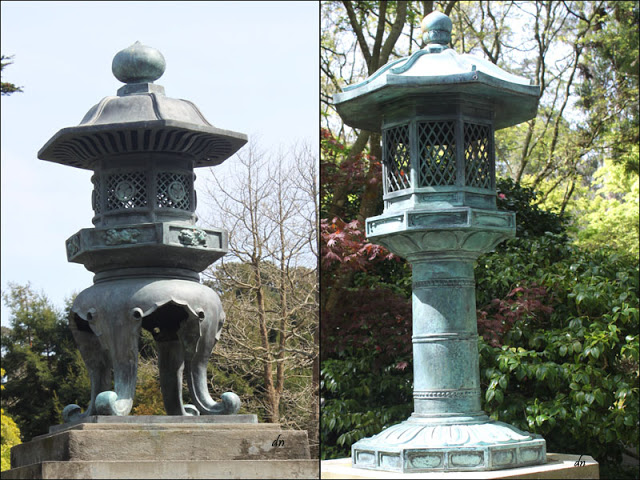
The Tea Garden has two Bronze lanterns near the Pagaoda. These lanterns that have been here since 1912 are said to date back to the Meija era (1868-1912). However they have had some restoration work done on them when the Japanese Tea Garden completed a 100 years.
The Peace Lantern (on the right, in the picture) also had a plaque placed to its side and it read:
THIS 9000 POUND BRONZE LANTERN WAS PURCHASED WITH CONTRIBUTIONS FROM SCHOOL CHILDREN OF JAPAN AS A SYMBOL OF FRIENDSHIP TO THE UNITED STATES. YASUSUKE KATSUNO, THE JAPANESE CONSUL GENERAL, FORMALLY PRESENTED THE PEACE LANTERN ON JANUARY 8, 1953. THE GIFT WAS A COMMEMORATION OF THE US-JAPANESE PEACE TREATY SIGNED IN SAN FRANCISCO IN 1951.
Main Pond and Stone Sculptures

Water as a design element is a quintessential one in a Japanese Garden. If there is no water, there will at least be some sand pools to make up for it. Koi (fish) ponds with colourful fish in them is another common feature in a Japanese Garden. Stone sculptures are another commonly used garden decoration as far as the Japanese are concerned.
Buddha
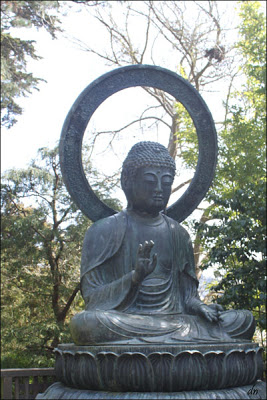
This bronze Buddha near the Tea house is said to have been cast in Tajima in Japan in 1790. It was presented to the Japanese Tea Garden by S&G Gump Company, an SF based mirror and frame shop.
Stone Lanterns
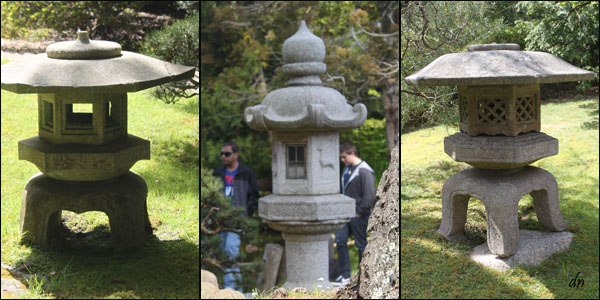
The plants and trees in Japanese a Garden are said to be chosen with great care. These Zen-influenced gardens usually have traditional plants like the Bamboo and lantern plants. You will find miniature trees too. They also have a fine mix of evergreen plants, and seasonal plants that lend other colours to the scene. That explains the Maple and Cherry trees here in the Japanese Tea Garden. I should go back in the Fall to see what these Maple trees would look like then but since I visited this garden in spring, I have enough pictures for a full photo feature on Cherry blossoms. That next.

Previous post: Japanese Tea Garden – I (A Brief History)
More
Japanese Gardens
For pictures from the road, Like/Follow Tipsy From The TRIP on Facebook.
Come, Trip with us. 😉











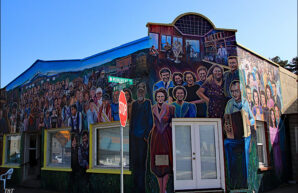

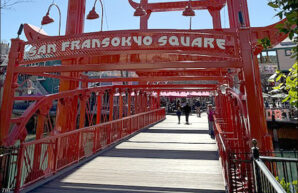

i have never been to a japanese garden…..must visit one soon(for that must locate one first!!)….
it looks so serene!!
http://sushmita-smile.blogspot.in/
Sushmita, you must. Considering your interest in gardens, you will fall in love with a Japanese Garden when you see one. I promise 🙂
…amazingly beautiful pics, Divya, and your graphic narration combined together make it a wonderful post indeed! Thoroughly enjoyed…!
Thank you Amit. 🙂
So informative and lovely images
Thank you Doc. 🙂
phew!! ur post made me do a little research. had to check pearl harbor dates to confirm that the us-japanese treaty was actually signed after the attack (i m so dumb :D). also had to find out what this koi fish is. we used to get a fish called koi fish here in my town but that's an entirely different one. next part please.
Wow! Deb, you are one serious reader, eh! See, you learn a lot from travel blogs :D. Isn't that so cool. When I learnt of that the Hagiwaras had to go to internment camps I was connecting it to a certain novel I read about a Japanese-American family and their experiences around the time of the Pearl Harbour attack: the camps and separation and all that.
Your Koi fish were in the fish market, eh? These Koi are generally show-fish, I believe. I remember seeing some in Singapore too.
The next part is just going to have some pictures. 🙂
Lovely post. Sounds so serene and peaceful and nice pictures. Ideal for spending some quality time with oneself i suppose….And great amount of info from you…:) Enjoyed thoroughly!!!
Sorry Jaish, I seem to missed your comment.
Thank you. Japanese gardens are really peaceful and beautifully landscaped places. I've been to a few; love them all!
Thanks again, Jaish. And sorry. 🙂
Truly fascinating… I totally loved this post!
Hey Vijay, Thank you.
pretty pics. and ur right-lks just like the one in singapore
🙂 Japanese Gardens everywhere should look like this, I guess. I've been to two Japanese Gardens and found them looking similar. These places really are very pretty.
WOW! I have never seen anything like this. Great pictures <3
Love
http://www.meghasarin.blogspot.com
Yeah, they're really lovely. Thank you Megha.
you were right – this one was even better 🙂
Wasn't it fascinating; this look into Japanese culture? I learnt quite a bit about the Japanese in the process of visiting this place and doing some reading about it.
Thank you for coming by, Sujatha. 🙂
I made a virtual tour of the Japanese tea garden through this blog. And now, I am pretty sure, I should be able to recognize one if I happen to come across one 🙂
That's so cool. I hope you get to see one soon. I'll come by and see the pictures. 🙂
nice to know about Japan
This is a mini-Japan.
Glad you liked it, Shrinidhi.
marvelous images and narration!
Thank you, Deepak.
A beautiful pictorial narration of the tea garden. It was as if I were roaming around it all, in the midst of miniature trees and traditionally Japanese construction.
That means I did well, right? I'm so happy you liked the vicarious tour, USP. I learnt so much from this visit to the tea garden. I should check out SF's Japantown sometime.
I want to be there just now!!!
🙂
A very visual and captivating post!Beautifully presented:)
Thank you, Mr. Bhatia. 🙂
Such a beautiful presentation of the Orient. Loved the narration in both the parts.
Thank you so much, Saru. 🙂 I'm so glad you liked it.
My sister stayed a few years in Japan. The pictures she sent home were simply out of this world. Japanese have a way of doing things… right!
Stayed in Japan for a year? Wow that must have been such a great experience. Yeah, they seem very meticulous
Aha ! A truly beautiful landscaped Japanese garden in the US! Imagine the centuries of learning that has been accumulated by which they create such beautiful gardens. A great post! 🙂
PS: Pls Pls remove the captcha and make the comments moderated 🙁
🙂 Thank you Puru.
Really, the captcha thing is annoying? 😀 It's worse than moderated comments? I thought people would prefer that, as they would be able to see their comments published right away.
Anyway I'm removing it. Thanks Puru for letting me know that it's not very user friendly. 🙂
Nice photography my friend.I am very much interested about your blog.
Thanks Animesh. Hope to see you here again.
D.Nambiar,
Well researched post! It gave me a virtual tour around the garden as many others commented.
Fantastic way of describing things.
Thank you Deepu. I learnt a lot too. It's fascinating, alle? 🙂
nice to see
🙂
[…] post: Japanese Tea Garden- II (Features and Symbolism) A park so prim and proper – pictures from Japanese Friendship Garden in San Jose, […]
[…] If elements of Japanese landscaping and their meanings are your subjects of interests you will like this post — Japanese Tea Garden, Features and symbolism. […]
[…] Japanese Tea Garden (SFO)- a brief history Japanese Tea Garden (features and symbolism) […]
[…] Japanese Tea Garden (features and symbolism) […]
[…] More Posts from this Japanese Garden:Japanese Tea Garden (SFO)- a brief historyJapanese Tea Garden (features and symbolism) […]